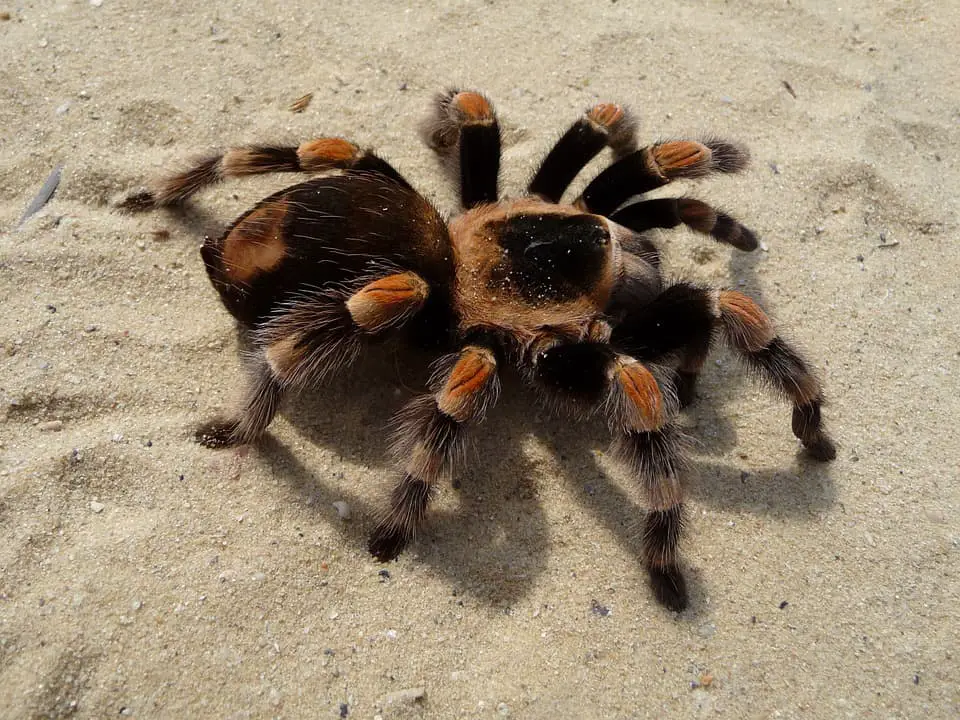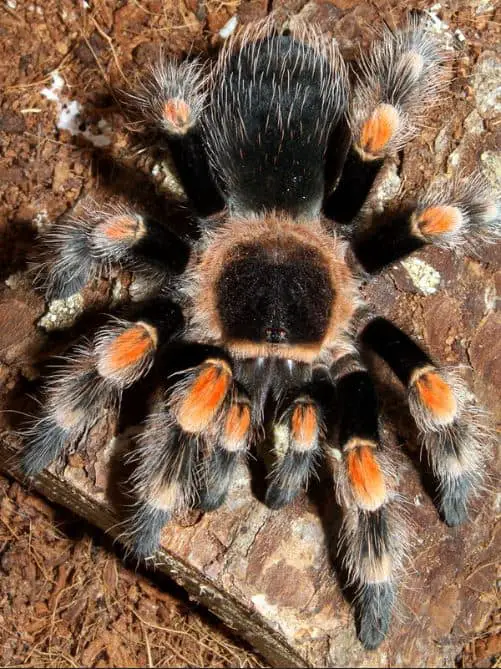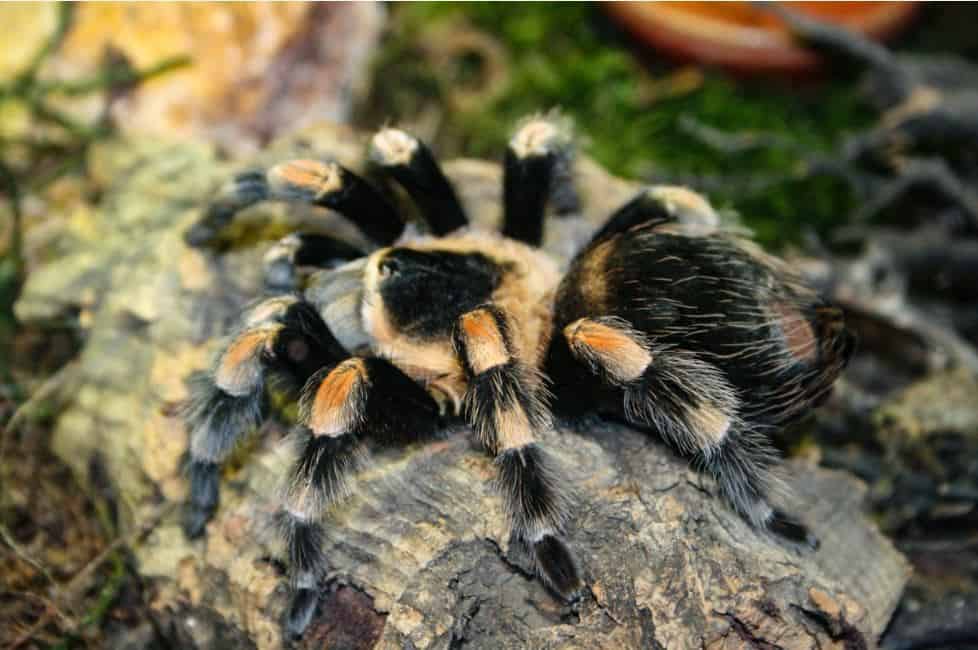The Mexican Red Knee tarantula (brachypelma hamorii) is a New World terrestrial tarantula native to Mexico. This species has often been confused with the Brachypelma smithi because they’re very similar in appearance.
The Mexican Red Knee is an incredibly popular species in the hobby due to its striking appearance and docile nature. This makes them especially suitable for first-timers and people who plan on handling their eight-legged friend.
If you’re considering getting this spider as a pet, or if you just got one, here is everything you need to know about them.

Mexican Red Knee Tarantula Care Sheet
| Species Name | Brachypelma Hamorii |
| Family Name | Theraphosidae |
| Common Names | Mexican Red Knee Tarantula |
| Category | New World |
| Type | Terrestrial |
| Native Location | Mexico |
| Leg Span | 5.5 inches (~14 cm) |
| Growth Speed | Slow |
| Urticating Hairs | Yes |
| Social | Solitary |
| Diet | Insects: primarily crickets and roaches |
| Temperature | 70 to 80 degrees °F |
| Humidity | 60 to 70% |
| Lifespan | Female: 25 to 30 years / Male: 10 years |
| Experience required | Beginner |
| Minimum tank size | 18″Lx18″Wx12″H |
Mexican Red Knee Tarantula Overview
The Brachypelma Hamorii, or Mexican Red Knee (MRKT) as they’re referred to in the hobby, is a terrestrial spider that’s native to the Sierra Madre Occidental and Sierra Madre del Sur mountain ranges in Mexico.
They live on the forest floors where they create burrows under logs, rocks, roots, or in tall grass. To catch prey, they spin silk in front of their burrow which alerts them when prey is nearby so that they can ambush it with their large fangs.
These large spiders are remarkably docile towards humans and have a very long lifespan, which is why they’ve become incredibly popular among hobbyists.
Appearance & Variants

The Mexican Red Knee Tarantula is a beautiful spider with a very characteristic appearance. They have a dark body, with red/orange bands on their knees. They also typically have orange coloration around their carapace and abdomen, and orange setae.
They’re an average-sized tarantula, topping out at a leg span of around 5.5 inches. Males are typically smaller than females, especially in the carapace and abdomen area. They also often have thinner and longer legs relative to the size of their body than females do.
Color-wise though, males and females of this species look very similar to one another.
As babies and juveniles, they typically do not have their characteristic orange and black appearance yet. Instead, they’re often a brownish color and will not reach their full coloration until they are adults.
This spider is often confused with the b. Smithi because of how similar they are in appearance. In fact, they look so similar that they’ve both been called Mexican Red Knee. Nowadays the b. hamorri is known in the hobby as the Mexican Red Knee, and the b. smithi is called the Smith’s Redknee Tarantula. Still, they’re very often confused because they’re almost identical in appearance to the untrained eye.
Price
Mexican Red Knee Tarantulas are not an expensive species. They’re many people’s first introduction to the spider-keeping hobby and are not difficult to breed nor rare, so breeders often have plenty of them in stock.
The final price you pay depends on what you’re looking for. Slings are the cheapest, so if you want to raise the spider from baby to adult expect to pay around $30 to $45 to buy one.
The price for an adult male is around $65, and an adult female costs around $225.
Temperament & Behavior

The Mexican Red Knee is a very calm tarantula. They’re not very defensive and tend to be quite docile. You really have to push them to get them to show a threat posture or for them to fling their urticating hairs.
When they feel threatened, they prefer to get out of harm’s way rather than fight.
However, they are still wild animals and they are capable of biting if they see no other way out. Luckily, these spiders do not have particularly potent venom, so even if you do get bitten (which almost never happens!) you should be just fine.
They’re very suitable for beginners due to the fact that they’re so docile, and are a great way for newcomers to the hobby to get some experience interacting with big spiders.
Furthermore, these tarantulas spend quite a bit of time out in the open. This, combined with their decent size and amazing coloration and pattern makes them a beauty of a show spider that should be in anyone’s collection.
Handling
The Mexican Red Knee Tarantula is a species that’s quite tolerant of being handled. They’re not very skittish and since they’re not defensive, they’re typically very easy to handle.
You do have to keep in mind though that while they might tolerate being handled, it’s not something they absolutely need.
They’re spiders, not cats or dogs, so they are not social animals. They do not need attention or affection and prefer to be left alone.
Nevertheless, handling your tarantula can be fun and if you do it right, it shouldn’t be too stressful for them either. To pick them up, place your hand in front of them and let them crawl onto your hand. You can slightly nudge them in the right direction with your finger on their abdomen.
Make sure that you handle them carefully though, because a drop can rupture their abdomen and be lethal. If you do decide to handle them, it’s best to do it close to the floor.
Caring for a Mexican Red Knee Tarantula

Tarantulas are very easy to care for. They’re not very demanding animals and it’s very easy to provide them with everything they need to thrive.
Their most important necessities are a proper enclosure that has a good temperature and humidity, good food, water, and proper substrate.
Here’s how you can provide them with that.
Tank setup
The Mexican Red Knee Tarantula is a terrestrial species. This means that in nature, they spend the majority of their time on the ground, not in the trees. As a result, their tank should have more horizontal than vertical space.
At a minimum, you should provide your spider with a tank that has 3 times as much horizontal space as the size of their leg span. So, if you have a 5-inch Mexican Red Knee, you should provide them with an enclosure that’s at least 15 inches wide.
A good enclosure that’ll fit pretty much any Mexican Red Knee Tarantula is the Exo Terra Small low terrarium.
To make this enclosure feel like home, make sure that you provide them with a hide. The hide can be a piece of hollow cork bark that’s placed in the enclosure, but can also be something as simple as a broken plant pot or half of a coconut shell. As long as it’s a place where they can retreat, feel safe, and have privacy, it’ll be good enough for them.
You can also place some rocks and artificial plants in the enclosure to make it more visually appealing.
Substrate
Good substrate is very important because this spider has a tendency to burrow. However, they do not burrow very deep, so a layer of substrate that’s about 4 inches deep will be sufficient.
Good material to use as substrate includes coconut fibers, peat moss, vermiculite, and potting soil. Many owners choose to use a combination of these materials because it’s easy to burrow into and retains moisture well which can help keep the humidity up.
Temperature & Humidity
The Mexican Red Knee is not particularly picky when it comes to temperature and humidity. They will do just fine at around room temperature but do best in temperatures that are between 75 and 80 degrees Fahrenheit. As long as you make sure that the temperature does not fall below 65 Fahrenheit, they will be okay.
As for humidity, try to reach a relative humidity level of around 60 to 70%. This will make it easier for them to molt and is generally a comfortable environment for them.
To measure the humidity in their enclosure you can use a hygrometer. If the humidity is too low, you can increase it by dripping a bit of water down the side of the enclosure.
It’s not recommended to make the substrate too moist, because the Mexican Red Knee Tarantula does not enjoy moist substrate and this can lead to her clinging to the glass instead of staying on the ground.
You can also give them a large water bowl so that the evaporation can increase the humidity in the air.
Social
the Mexican Red Knee is not a social tarantula. They do not live communally and will resort to cannibalism if you place more than one of these spiders in the same enclosure. To keep them safe, house them solitarily.
Molting
As all tarantulas do, the Mexican Red Knee will molt from time to time. If you’ve never had a tarantula before and see this for the first time it might seem a bit weird and confusing, but it’s totally normal behavior. It’s basically the process of them shedding their old skeleton, which has gotten too small so that they can keep growing.
An important thing to note is that they will stop eating before a molt to make the process easier. During the molt, it’s important that you do not disturb them, as this can result in a failed molt, which can lead to them losing a leg or a fang.
It is also important that you do not feed them for several days after a molt. They need time for their fangs to harden before they are able to eat.
Diet & Feeding

You should feed your Mexican Red Knee Tarantula a diet that consists of insects.
Mexican Red knee sling should be fed flightless fruit flies or cricket legs. They’re too small to eat larger insects at this stage, so don’t feed them anything larger than that. In the wild, they’re scavengers at this size, so they’re perfectly fine with eating pre-killed prey.
Once they grow into their juvenile stage, they can start eating a small to medium-sized cricket once or twice a week.
As adults, they can eat quite a bit. A fully grown Mexican Red Knee Tarantula can eat 6 to 8 large crickets every other week. They have a decent appetite, but they do have a reputation for sometimes refusing to eat. This is normal behavior, and tarantulas can for a long time without eating, so it’s usually not something to worry about.
To change up their diet, you can also feed them mealworms, dubia roaches, or superworms from time to time. Some owners also choose to feed them
The amount your tarantula needs to eat does vary from specimen to specimen, so keep an eye on the size of their abdomen to determine whether you’re feeding them too much or not enough. If the abdomen is getting smaller, you might want to increase the amount you’re feeding them while if it gets too big, you might be overfeeding them.
As for drinking, tarantulas drink exclusively water.
Slings that are too small to drink from a bowl will drink the droplets that are found around the enclosure.
If you want to provide them with more water, you can spray the side of the enclosure so that droplets will form on the glass, which will then drip down.
Alternatively, you can drip some water down the side of the enclosure.
Adults will drink from a water bowl. Make sure that they always have access to plenty of water.
You might not see your tarantula drinking a whole lot. The reason for this is that they get a lot of the water they need from the food they eat. Additionally, they might be drinking at night while you’re asleep.
Lifespan & Health
The Mexican Red Knee Tarantula has an extremely long lifespan. Females can live for 25 to 30 years, whereas males typically live for around 10 years. This is important to keep into consideration because if you do get a female, you’ll have to be prepared to care for it for at least 2 decades.
They generally don’t have a lot to fear in captivity, and can easily reach their full lifespan, as long as you take the following precautions to keep them healthy.
First, make sure that you keep their enclosure clean and remove uneaten food within 24 hours. This is to prevent the growth of bacteria, mold, and fungus. It also helps to prevent spider mites.
Secondly, make sure that you only feed them captive-bred insects. Wild-caught insects can contain parasites, and those can spread to the spider if you feed them.
Thirdly, be very careful of falls. Terrestrial tarantulas like the MRKT can easily die from a fall. Make sure that if you do decide to handle them that you do so very carefully so that you do not drop them. Also, make sure that their enclosure is not too tall.
Mexican Red Knee Tarantula Facts
- They’re the most common pet tarantula
- They are movie stars! They starred in Indiana Jones and Kingdom of the Spiders.
- Their population was in decline for a long time due to the pet trade and the fact that they were considered pests by the locals. Make sure to buy captive-bred specimens from reputable sellers!
- The B. hamorii grows very slowly and matures late in life
Final words: Is the Mexican Red Knee right for you?
The Mexican Red Knee is a beautiful spider that’s good for any hobbyist. Absolute beginners, as well as the most experienced keepers, will love having this species in their collection. In fact, it’s one of those spiders that’s a must-have for many hobbyists.
They’re docile, easy to handle, have a long lifespan, and spend much of their time out in the open. On top of that, they’re relatively affordable and easy to care for. What’s not to love?
- How Long Do American Eskimo Dogs Live? Important Factors and Care Tips - September 29, 2023
- Do American Bulldogs Need Grooming? Essential Tips and Care Guidelines - September 29, 2023
- Do Bengal Cats Enjoy Playing? Essential Tips for Keeping Them Active - September 29, 2023